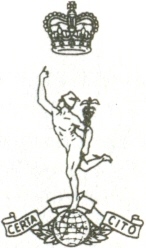Royal Corps of Signals, British Army: Difference between revisions
No edit summary |
Knorrepoes (talk | contribs) m (Text replacement - "{{media1}}" to "{{media}}") |
||
| Line 21: | Line 21: | ||
{{uk}} | {{uk}} | ||
{{ | {{media}} | ||
[[Category:Military heraldry of the United Kingdom]] | [[Category:Military heraldry of the United Kingdom]] | ||
[[Category:Army heraldry]] | [[Category:Army heraldry]] | ||
Revision as of 10:37, 4 August 2023
ROYAL CORPS OF SIGNALS, BRITISH ARMY
History: formed in 1920.
| (Queen Elizabeth II Version) |
(King Charles III Version) |
Official blazon
The Figure of Mercury holding a caduceus in his left hand, his right hand held aloft, poised on a globe with his left foot, the globe superimposed on a scroll inscribed with the corps motto "Certa Cito" (Swift and Sure); the whole ensigned with a crown which is detached from the remainder of the badge. Mercury and the globe in silver plate, crown and scroll in gilt or gilding metal.
Origin/meaning
The badge is Hermes/Mercury in Greek and Roman Mythology the Messenger of the Gods. Thus Symbolizing the Communication role of the Corps. He stands on a Globe signifying the Worldwide operations of the Corps.
Literature: Image from Wikimedia Commons. King Charles III Version from Defence Brand Portal Ministry of Defence
| Heraldry of the World |
| British heraldry portal Civic heraldry of the United Kingdom |
|
Contact and Support
Partners:
Your logo here ?
Contact us
© since 1995, Heraldry of the World, Ralf Hartemink 
Index of the site













